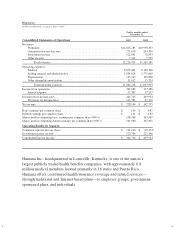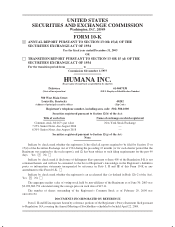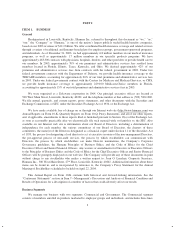Humana 2003 Annual Report Download - page 17
Download and view the complete annual report
Please find page 17 of the 2003 Humana annual report below. You can navigate through the pages in the report by either clicking on the pages listed below, or by using the keyword search tool below to find specific information within the annual report.
The following table summarizes our total medical membership at December 31, 2003, by market and
product:
Commercial Government
Percent
of TotalHMO PPO ASO
Medicare+
Choice Medicaid TRICARE Total
(in thousands)
Florida .................... 179.5 83.8 20.1 229.1 55.3 429.4 997.2 14.7%
Illinois .................... 257.4 214.0 82.9 40.2 18.8 74.7 688.0 10.2
Texas ..................... 205.7 324.2 41.6 21.3 — — 592.8 8.8
Puerto Rico ................ 17.1 67.4 11.1 — 394.8 — 490.4 7.2
Ohio ...................... 157.6 61.9 136.3 — — 73.0 428.8 6.3
Kentucky .................. 34.5 202.6 116.7 — — 67.7 421.5 6.2
Wisconsin ................. 83.7 51.9 182.9 2.6 — 32.2 353.3 5.2
Georgia ................... 17.4 34.6 1.8 — — 277.0 330.8 4.9
Virginia ................... — 1.2 — — — 187.8 189.0 2.8
North Carolina .............. — 12.4 2.6 — — 152.1 167.1 2.5
Arizona ................... 34.3 66.6 41.0 15.5 — — 157.4 2.3
South Carolina .............. — 3.8 0.6 — — 133.7 138.1 2.0
Tennessee ................. — 35.8 13.1 — — 82.1 131.0 1.9
Michigan .................. — 47.4 2.6 — — 60.2 110.2 1.6
Alabama .................. — — 0.2 — — 105.8 106.0 1.6
Indiana .................... 0.9 36.7 20.1 — — 44.8 102.5 1.5
Missouri/Kansas ............ 40.8 22.2 5.4 18.3 — 5.0 91.7 1.4
Mississippi ................. — 2.9 0.3 — — 75.4 78.6 1.2
Colorado .................. — 41.5 — — — — 41.5 0.6
TRICARE ASO ............. — — — — — 1,057.2 1,057.2 15.6
Others .................... — 13.0 33.1 1.6 — 48.8 96.5 1.5
Totals ..................... 1,028.9 1,323.9 712.4 328.6 468.9 2,906.9 6,769.6 100.0%
Provider Arrangements
We provide our members with access to health care services through our networks of health care providers
with whom we have contracted, including hospitals and other independent facilities such as outpatient surgery
centers, primary care physicians, specialist physicians, dentists and providers of ancillary health care services and
facilities. We have approximately 463,300 contracts with health care providers participating in our networks,
which consist of approximately 294,400 physicians, 3,300 hospitals, and 165,600 ancillary providers and
dentists. These ancillary services and facilities include ambulance services, medical equipment services, home
health agencies, mental health providers, rehabilitation facilities, nursing homes, optical services, and
pharmacies. Our membership base and the ability to influence where our members seek care generally enable us
to obtain contractual discounts with providers.
We use a variety of techniques to provide access to effective and efficient use of health care services for our
members. These techniques include the coordination of care for our members, product and benefit designs,
hospital inpatient management systems, or HIMS, and enrolling members into various disease management
programs. The focal point for health care services in many of our Medicare+Choice and HMO networks is the
primary care physician who, under contract, provides services, and may control utilization of appropriate
services, by directing or approving hospitalization and referrals to specialists and other providers. Some
physicians may have arrangements under which they can earn bonuses when certain target goals relating to the
provisions of quality patient care are met. Our HIMS programs use specially-trained physicians to effectively
manage the entire range of an HMO member’s medical care during a hospital admission and to effectively
coordinate the member’s discharge and post-discharge care. We have available a variety of disease management
programs related to specific medical conditions such as congestive heart failure, coronary artery disease, prenatal
9
























